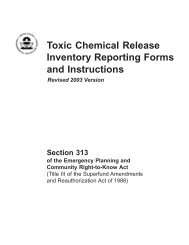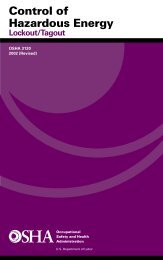OSHA 3138 - Seton Resource Center
OSHA 3138 - Seton Resource Center
OSHA 3138 - Seton Resource Center
Create successful ePaper yourself
Turn your PDF publications into a flip-book with our unique Google optimized e-Paper software.
■<br />
floor that slopes downward and tapers to a smaller cross<br />
section; and/or<br />
Contains any other recognized serious safety or health hazards.<br />
<strong>OSHA</strong>’s Confined Space Standard<br />
<strong>OSHA</strong>’s standard for confined spaces (29 CFR 1910.146) contains<br />
the requirements for practices and procedures to protect employees<br />
in general industry from the hazards of entering permit spaces.<br />
Employers in general industry must evaluate their workplaces to<br />
determine if spaces are permit spaces. (See flow chart, page 5.) If a<br />
workplace contains permit spaces, the employer must inform<br />
exposed employees of their existence, location and the hazards<br />
they pose. This can be done by posting danger signs such as<br />
“DANGER—PERMIT-REQUIRED CONFINED SPACE—AUTHORIZED<br />
ENTRANTS ONLY” or using an equally effective means.<br />
If employees are not to enter and work in permit spaces,<br />
employers must take effective measures to prevent them from<br />
entering these spaces. If employees are expected to enter permit<br />
spaces, the employer must develop a written permit space program<br />
and make it available to employees or their representatives.<br />
Alternative to a full permit entry<br />
Under certain conditions described in the standard, the<br />
employer may use alternate procedures for worker entry into a<br />
permit space. For example, if an employer can demonstrate with<br />
monitoring and inspection data that the only hazard is an actual or<br />
potential hazardous atmosphere that can be made safe for entry<br />
using continuous forced air ventilation, the employer may be<br />
exempted from some requirements, such as permits and attendants.<br />
However, even in these circumstances, the employer must<br />
test the internal atmosphere of the space for oxygen content,<br />
flammable gases and vapors, and the potential for toxic air contaminants<br />
before any employee enters it. The employer must also<br />
provide continuous ventilation and verify that the required measurements<br />
are performed before entry.<br />
4
















